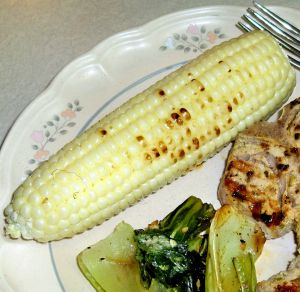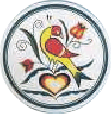Corn on the Cob
I know there are people out there who do not like, or who are allergic to corn on the cob, but I have yet to meet any of them. One of the things I look forward to most about the summer harvest is the fresh corn that comes out of the field in the morning and makes its way to the dinner table the same day. I have picked corn many times and I can never resist eating the first cob raw before I start to pick the second. That is the ultimate treat. However, it is equally delightful to smother hot cobs with butter that drips all the way from plate to mouth. I am one of those people who suck on the bare cob, sometimes rolled in the excess melted butter on the plate, to get any remaining milky goodness long after the kernels have been devoured.

Corn comes in many varieties, from sweet to sweeter to super sweet, from white to yellow to a combination of both. I think that yellow corn has the most corn flavor because it is not as sweet. However, it is best when picked locally and cooked the same day. Good sweet corn is now available all year long due to newer varieties that hold up for longer periods. Corn can be frozen when first harvested and is almost as delicious as fresh.
No matter what method you use to cook your corn, never overcook it. Corn at its best is very milky inside and should retain that moisture when heated. If overcooked, it will dry out quickly. Also, despite what you were taught, never salt corn before cooking. Salt pulls out moisture from any food and, again, the corn will dry out when cooking. Some people like to add a little sugar when boiling corn. I do that on occasion, but only when the corn is not as flavorful.
Cooking Methods
Boiled Corn on the Cob
There are two methods for boiling. The first is to place the shucked corn in cold water and bring to a boil and the second is to place the corn into boiling water. I prefer the second method, cooking the corn for 4 minutes. If you like the corn to be very tender, cook an additional 2 minutes. Drain off all but a little of the water and keep it on a very low burner, partially covered, until needed. It never overcooks. However, this method works best when you are making a limited amount of ears that will fit in a large, deep skillet or sauté pan. I never completely cover the ears with the water which is why they do not overcook. I do turn them over once through the process. Placing the shucked corn in a large soup or stock pot with cold water and bringing it to a boil works well with larger amounts of corn. You simply cook the corn until the water comes to a boil and it is done. No timing is required, just pot-watching. However, if you prefer very tender corn, let it cook in the boiling water for a few minutes.
Steamed Corn on the Cob
This method takes about twice as long as boiling and works best with just a few cobs of corn. Put enough water in the bottom of a pot or double boiler to come just below the steamer basket. Bring to a boil. Place the shucked corn in the basket, cover and steam until hot, about 8 minutes, longer if you want it soft.
Roasted Corn on the Cob
Roasting corn, as well as grilling, is a little more complicated because you need to be certain that the corn is prepared in such a way that it will retain its moisture during dry cooking. Preheat oven to 400° F. Spread butter on the shucked corn and then wrap each cob separately in foil, twisting the edges to seal. Roast until hot, about 10 minutes. If you prefer your corn to be more tender, use a lower temperature and roast longer.
Grilled Corn on the Cob
There are four methods for grilling corn. The first is similar to roasting. Spread butter on the shucked corn, wrap the individual cobs in foil and twist the edges to seal. Grill for about 8 minutes, depending on direct or indirect heat source, turning several times. For the second method, you need to pull back the husks, remove the silks, then return the husks to their original place wrapping the corn, and secure the tops with a string. The corn is then soaked in water to prevent the husks from burning. The third method is to first boil the shucked corn for about 4 minutes, then spread the cooked corn with butter and place on the grill over direct heat, turning until some of the kernels brown. The last method, my personal favorite, is to place the shucked, uncooked cobs directly on the grill and cook, turning as needed, until some of the kernels have browned. The browning adds flavor but the kernels maintain their fresh crispy texture.
Microwaved Corn on the Cob
You can cook corn in the microwave when you are cooking for one or two. Shuck the corn, wrap it in waxed or parchment paper, twist the edges and microwave on high for 2 minutes, depending on the wattage of your microwave. Works perfectly and is just as good as boiling.

No matter where I take my guests, it seems they like my kitchen best.
Pennsylvania Dutch Saying
This site may not be reproduced in whole or in part without written permission and appropriate credit given. Written, designed and maintained by Teri Ranck Foster. All rights reserved. Copyright Statement, Privacy Policy and Disclaimers.


